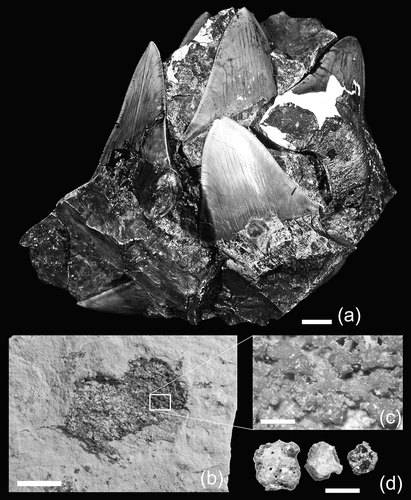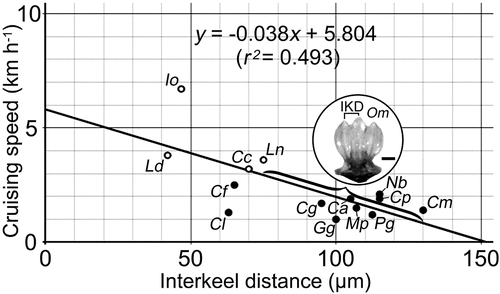Figures & data
Figure 1. Representative examples of associated teeth and tessellated calcified cartilage fragments from an individual of Otodus megalodon from the upper Miocene of northern Saitama Prefecture, Japan. (a), part of associated tooth set in rock matrix (archival photograph of SMNH: see Uyeno et al. Citation1989, plate 1a); (b), fragment of tessellated calcified cartilage in rock matrix (SMNH-VeF-377); (c), close-up view of tessellated calcified cartilage depicted in Figure 1(b) (SMNH-VeF-377); (d), three samples of disaggregated tesserae (SMNH-VeF-377: left and middle samples = exterior view; right sample = broken surface showing transverse cross-sectional view). Scale bar: (a) and (b) = 1 cm; (c) and (d) = 1 mm.

Table 1. Representative interkeel distance (IKD) of Otodus megalodon and two other extinct lamniforms compared to reported representative (‘modal’ or average) IKD of ‘non-fin’ (= head or body) placoid scales, along with reported cruising speed (CS), in non-embryonic pelagic lamniform and carcharhiniform sharks measuring 100+ cm TL with keeled placoid scales (excluding Mitsukurina owstoni, Alopias superciliosus, Triaenodon obesus, and Galeocerdo cuvier that have thorn-like and/or sparsely distributed (= less dense) placoid scales on their body, but Megachasma pelagios is included because it has rather densely spaced scales with well-defined keels: see Reif Citation1985b; Frumkin and Shimada Citation2020). Note that, although the TL of each individual for which IKD was taken is given, which does not necessarily correspond to the TL of the individual for which CS was measured, it is assumed here that IKD is independent of TL based on Raschi and Elsom’s (Citation1986) study. Additional legends: ‘L’ for Lamniformes and ‘C’ for Carcharhiniformes under ‘Order’; brackets ([]), tentative CS estimation based on regression equation in (see text for detail); asterisk (*), average value.
Table 2. Reported cruising speeds of extant pelagic lamniform and carcharhiniform sharks represented in in terms of ‘body length/second’ (BL/s) (based on Cooper et al. Citation2022, data S1, which also provide original references; each BL/s is based on the largest individual for each species listed in the data set; excludes Alopias vulpinus), along with interkeel distance (IKD) from (see text for treatment of species with multiple samples).
Figure 2. Representative examples of placoid scales (SMNH-VeF-378) from an individual of Otodus megalodon from the upper Miocene of northern Saitama Prefecture, Japan. (a)–(d), ‘Type I’ scales; (e)–(h), ‘Type II-a’ scales; (i)–(l), ‘Type II-b’ scales; (m)–(p), ‘Type III-a’ scales; (q)–(t), ‘Type II-b’ scales (see text for scale types). Orientations (from left to right): apical (anterior to top), basal (anterior to top), profile (anterior to left), anterior, and posterior views. Scale bar = 0.5 mm.

Figure 3. Linear regression showing the relationship between interkeel distances (IKD) of placoid scales and reported cruising speeds across 14 extant lamniform and carcharhiniform species with keeled placoid scales (see and text; excludes Alopias spp. and Sphyrna spp. with highly derived body forms; solid circle plots indicate ectothermic taxa, and open circle plots indicate regionally endothermic taxa). The bracket along the regression line shows the total range of IKDs (75–130 µm) observed in Type II-b placoid scales of Otodus megalodon reported here, and the inset shows a representative example in anteroapical view (one of SMNH-VeF-378; scale bar = 100 µm). Species abbreviations: Ca, Carcharhinus amblyrhynchos; Cc, Carcharodon carcharias; Cf, Carcharhinus falciformis; Cg, Carcharhinus galapagensis; Cl, Carcharhinus limbatus; Cm, Carcharhinus melanopterus; Cp, Carcharhinus plumbeus; Gg, Galeorhinus galeus; Io, Isurus oxyrinchus; Ld, Lamna ditropis; Ln, Lamna nasus; Mp, Megachasma pelagios; Nb, Negaprion brevirostris; Om, Otodus megalodon; Pg, Prionace glauca.

